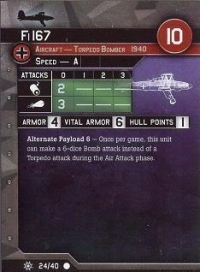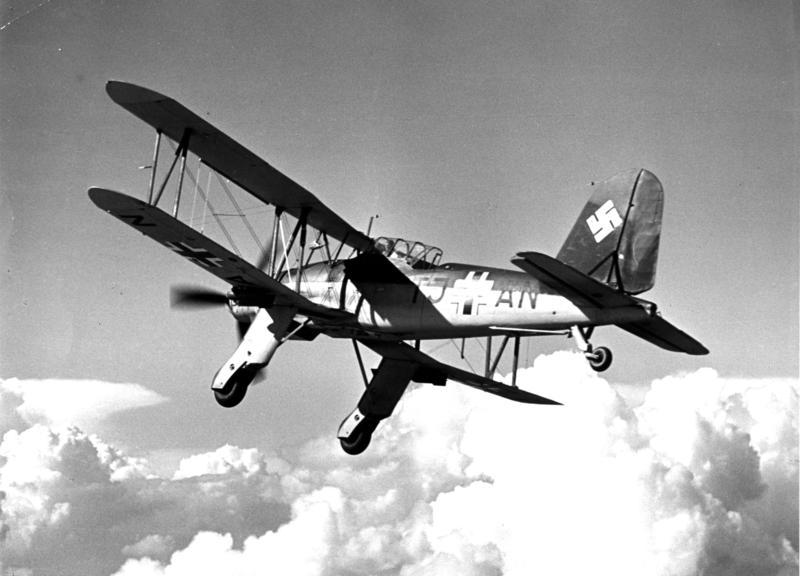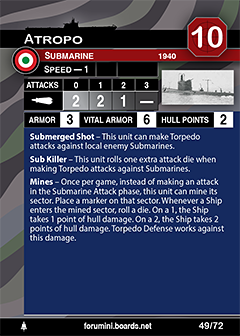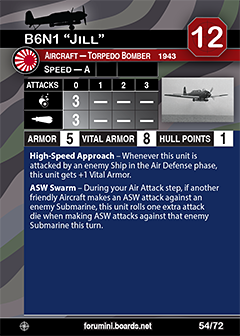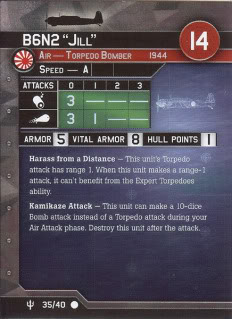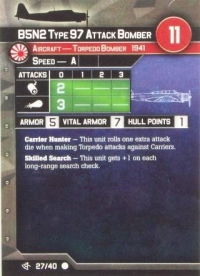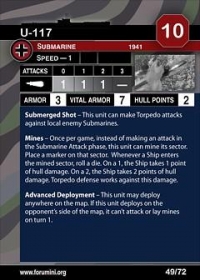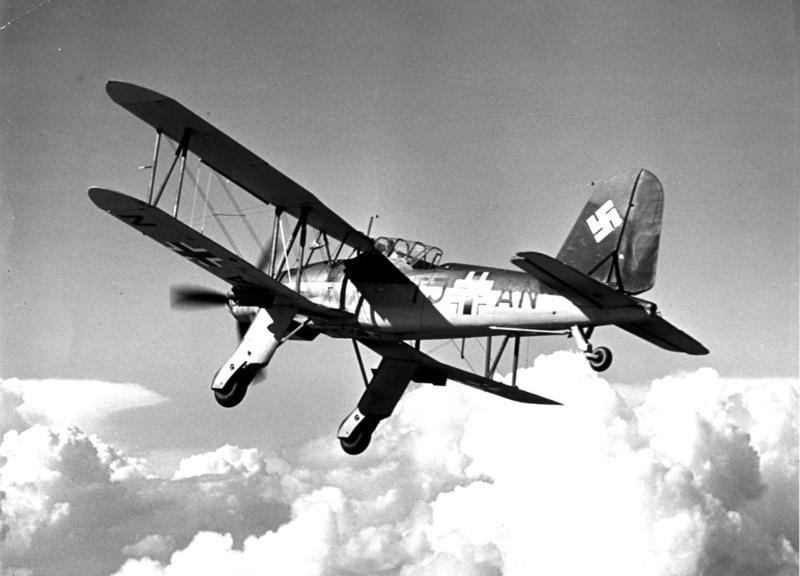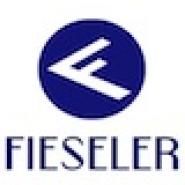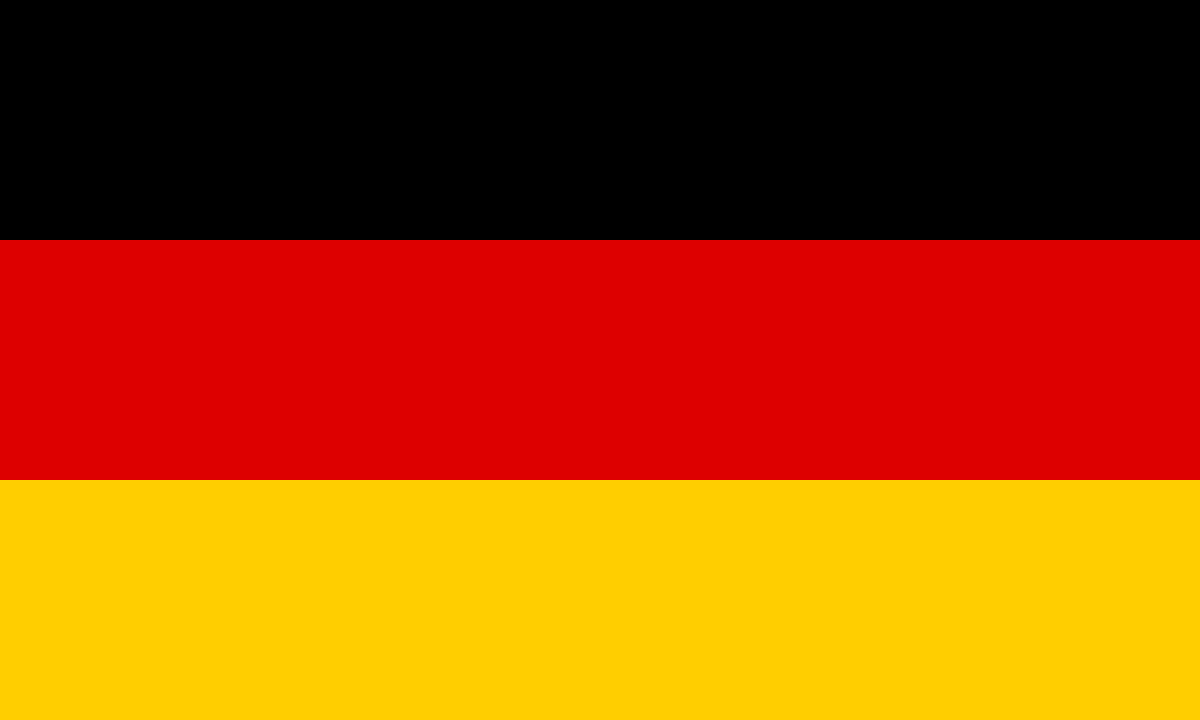Fi 167
| General Type | Aircraft |
| Unit Type | Torpedo Bomber |
| Cost | 10 |
| Set | Condition Zebra |
| Manufacturer | Hasbro |
| Available | 1940 |
| Set ID | 24 |
| Game Class Limits | Fieseler |
| Country | Germany (Details) |
| Prototype | Aircraft, Propeller, Fieseler Fi 167 (Details) |
| Armor | 4 |
| Vital | 6 |
| Hull Points | 1 |
| Speed | 139 |
| Primary | 0/0/0/0 |
| Torpedoes | 3/0/0/0 |
| ASW | 2/-/-/- |
| Special Ability | Alternate Payload 6 |
| Game Rarity | C |
Click to see the details
market
Click to see the details
history
Click to see the details
collector
Notes:
In early 1937, the Reichsluftfahrtministerium (German Ministry of Aviation) issued a specification for a carrier-based torpedo bomber to operate from Germany's first aircraft carrier, the Graf Zeppelin construction of which had started at the end of 1936. The specification was issued to two aircraft producers, Fieseler and Arado, and demanded an all-metal biplane with a maximum speed of at least 300 km/h (186 mph), a range of at least 1,000 km and capable both of torpedo and dive-bombing. By the summer of 1938 the Fiesler design proved to be superior to the Arado design, the Ar 195.
Since the Graf Zeppelin was not expected to be completed before the end of 1940, construction of the Fi 167 had a low priority. When construction of the Graf Zeppelin was stopped in 1940, the completion of further aircraft was stopped and the completed examples were taken into Luftwaffe service in the Erprobungsgruppe 167 evaluation/test unit.
When construction of the Graf Zeppelin was resumed in 1942 the Ju 87C took over the role as a reconnaissance bomber, and torpedo bombers were no longer seen to be needed. Nine of the existing Fi 167 were sent to a coastal naval squadron in the Netherlands and then returned to Germany in the summer of 1943. After that they were sold to Croatia.
The Fi 167's short-field landing and load-carrying abilities made it ideal for transporting ammunition and other supplies to besieged Croatian Army garrisons, between their arrival in September 1944 and the end of the War.
From Wikipedia
Since the Graf Zeppelin was not expected to be completed before the end of 1940, construction of the Fi 167 had a low priority. When construction of the Graf Zeppelin was stopped in 1940, the completion of further aircraft was stopped and the completed examples were taken into Luftwaffe service in the Erprobungsgruppe 167 evaluation/test unit.
When construction of the Graf Zeppelin was resumed in 1942 the Ju 87C took over the role as a reconnaissance bomber, and torpedo bombers were no longer seen to be needed. Nine of the existing Fi 167 were sent to a coastal naval squadron in the Netherlands and then returned to Germany in the summer of 1943. After that they were sold to Croatia.
The Fi 167's short-field landing and load-carrying abilities made it ideal for transporting ammunition and other supplies to besieged Croatian Army garrisons, between their arrival in September 1944 and the end of the War.
From Wikipedia
Aircraft History:
The Fieseler Fi 167 was a 1930s German biplane torpedo and reconnaissance bomber designed for use from the Graf Zeppelin class aircraft carriers under construction from 1936 to 1942.
When construction of the Graf Zeppelin was resumed in 1942 the Ju 87C took over the role as a reconnaissance bomber, and torpedo bombers were no longer seen to be needed. The Fi 167s returned to Germany in the summer of 1943. After that they were sold to Croatia, The Fi 167's short-field landing and load-carrying abilities made it ideal for transporting ammunition and other supplies to besieged Croatian Army garrisons, between their arrival in September 1944 and the end of the War.
When construction of the Graf Zeppelin was resumed in 1942 the Ju 87C took over the role as a reconnaissance bomber, and torpedo bombers were no longer seen to be needed. The Fi 167s returned to Germany in the summer of 1943. After that they were sold to Croatia, The Fi 167's short-field landing and load-carrying abilities made it ideal for transporting ammunition and other supplies to besieged Croatian Army garrisons, between their arrival in September 1944 and the end of the War.
Manufacturer:
The firm was founded on April 1, 1930 as Fieseler Flugzeugbau Kassel by World War I flying ace and aerobatic champion Gerhard Fieseler. Fieseler had been a manager for the Raab-Katzenstein, but when this company went bankrupt, Fieseler bought a sailplane factory in Kassel and quickly turned it to building sports planes. At the same time, Fieseler still custom-built sailplanes for some of Germany's most prominent designers and pilots, including Wolf Hirth's "Musterle" and Robert Kronfeld's "Wien" and "Austria" (for many years the largest sailplane ever built).
In 1934, the company achieved prominence when Fieseler won the World Aerobatics Championship in an aircraft his company had built, the F2 Tiger. This was followed by the highly successful F5, generally regarded as a classic among sports planes. Even greater success was to follow in 1936 when an aircraft of Fieseler's own design won a tender over aircraft from both Messerschmitt and Siebel for a new STOL observation and liaison aircraft for the Luftwaffe. It was designated the Fieseler Fi 156 Storch (Stork), and the company would produce over 3,000 during World War II. In 1937 Fieseler also produced the Fieseler Fi 253.
On April 1, 1939 the company name changed to the Gerhard Fieseler Werke GmbH.
Fieseler's other wartime production would largely consist of building other firms' aircraft under licence, including the Messerschmitt Bf 109 and Focke-Wulf Fw 190. In 1941 however, a Fieseler project for an unpiloted flying bomb (Fi 103) attracted the attention of the RLM (Reichsluftfahrtministerium - "Reich Aviation Ministry"). This went into production as the Fieseler FZG-76 (flakzielgerät, antiaircraft targeting device), better known as the V-1.
The Fieseler factory was the target of many Allied air raids, but continued production throughout the war. Following the War, part of the factory continued in business for a few years, producing automotive components. Its most famous products, the Storch and the V1, continued to be produced by foreign companies.
In 1934, the company achieved prominence when Fieseler won the World Aerobatics Championship in an aircraft his company had built, the F2 Tiger. This was followed by the highly successful F5, generally regarded as a classic among sports planes. Even greater success was to follow in 1936 when an aircraft of Fieseler's own design won a tender over aircraft from both Messerschmitt and Siebel for a new STOL observation and liaison aircraft for the Luftwaffe. It was designated the Fieseler Fi 156 Storch (Stork), and the company would produce over 3,000 during World War II. In 1937 Fieseler also produced the Fieseler Fi 253.
On April 1, 1939 the company name changed to the Gerhard Fieseler Werke GmbH.
Fieseler's other wartime production would largely consist of building other firms' aircraft under licence, including the Messerschmitt Bf 109 and Focke-Wulf Fw 190. In 1941 however, a Fieseler project for an unpiloted flying bomb (Fi 103) attracted the attention of the RLM (Reichsluftfahrtministerium - "Reich Aviation Ministry"). This went into production as the Fieseler FZG-76 (flakzielgerät, antiaircraft targeting device), better known as the V-1.
The Fieseler factory was the target of many Allied air raids, but continued production throughout the war. Following the War, part of the factory continued in business for a few years, producing automotive components. Its most famous products, the Storch and the V1, continued to be produced by foreign companies.
Country:
Germany is a Western European country with a landscape of forests, rivers, mountain ranges and North Sea beaches. It has over 2 millennia of history. Berlin, its capital, is home to art and nightlife scenes, the Brandenburg Gate and many sites relating to WWII. Munich is known for its Oktoberfest and beer halls, including the 16th-century Hofbräuhaus. Frankfurt, with its skyscrapers, houses the European Central Bank.
Item created by: Lethe
on 2015-05-31 17:46:30
Last edited by: gdm on 2019-10-28 08:16:53
If you see errors or missing data in this entry, please feel free to log in and edit it. Anyone with a Gmail account can log in instantly.
Last edited by: gdm on 2019-10-28 08:16:53
If you see errors or missing data in this entry, please feel free to log in and edit it. Anyone with a Gmail account can log in instantly.


